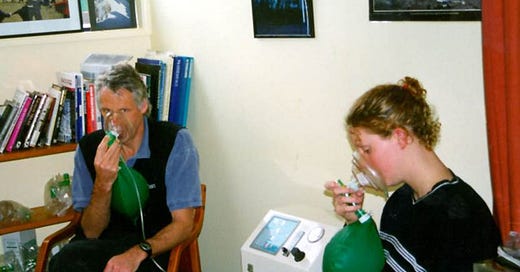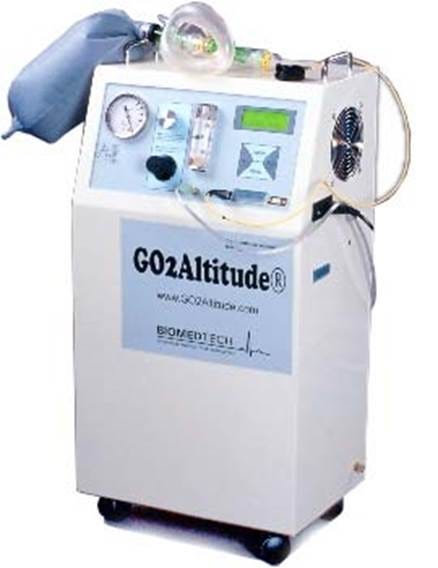Intermittent Hypoxic Exposure (IHE) is exposure to short periods of altitude (hypoxic) air containing 9-15% oxygen, alternated with sea-level (normoxic) air, which contains 20.9% oxygen, while being sedentary. Initially, this was called Intermittent Hypoxic Training, but when athletes started using this method while active, it became Intermittent Hypoxic Exposure (IHE) versus Intermittent Hypoxic Training (IHT) when done actively.
The conventional protocol for IHE consists of 5 minutes of hypoxic breathing, alternated by 5 minutes of breathing normal air for 60-90 minutes per day, 5-6 days per week for a minimum of 2-3 weeks.
Because of the intermittent nature of the hypoxic exposure, very low oxygen concentrations in the inhaled air can be tolerated safely, resulting in a significant drop in oxygen saturation in the blood. This becomes the stressor that stimulates the initiation of more efficient oxygen processing mechanisms. Like an altitude tent, an air compressor pumps air into a hypoxicator, which extracts oxygen and replaces it with nitrogen. The flow rate decides how much air is extracted, and oxygen flows out of the machine and is supplied to the user via a mask. A hypoxicator creates air with an oxygen content of 9%-15%, comparable with an altitude of 2,700-6000 meters above sea level. (Figure 1)

IHE uses higher altitudes than recommended when sleeping in a tent or doing conventional, natural altitude training. If applied for long periods, including overnight, it is likely to result in side effects, including symptoms of altitude sickness. As the hypoxic load is much greater with IHE, it causes a greater drop in the blood's oxygen concentration (SpO2). This can only be tolerated because it is short and followed by a recovery period with normal air. It results in physiological adaptions similar to the more conventional altitude training methods. Adaptations start after one session and continue in the first 2-3 weeks. This can then be maintained or further enhanced by ongoing use and/or combined with other altitude training methods.
As a coach, both chronic low hypoxic dose exposure (hours, days, weeks) and intermittent (acute) high hypoxic dose exposure makes sense to me. The first can be compared to low-intensity endurance training and the second with high-intensity interval training. Thus, altitude training becomes an additional training stress, which can be manipulated via frequency, duration and intensity of exposure, and it can be periodised throughout the year, just like physical training. There are different adaptations between physical endurance and interval training, but a significant overlap exists. The same is the case for chronic and intermittent hypoxic exposure.
Historical Perspective
I was made aware of IHE and IHT by Alexei Korolev, a Russian medical specialist in aerospace and aviation medicine, who immigrated to New Zealand in the early nineties and somehow found out about my interest in altitude training. His explanation about the benefits of IHE, backed by many scientific studies (translated from Russian….), convinced me to purchase a unit, which had to come from Russia. It was installed in my medical practice for use by athletes and patients in 1997. It must have been one of the first, if not the first, hypoxicator installed in a clinic outside of Russia.
Intermittent hypoxic exposure in Russia goes as far back as the 1930’s. The need for rapid altitude acclimatisation occurred in the years before World War 2 when Soviet pilots flew at altitudes of around 5000-6000 meters in open cockpits. They suffered unexplained blackouts during their flights, thought to be caused by the thin altitude air combined with gravitational forces when suddenly changing direction. Russian scientist Sirotinin conducted the first research into effective methods of altitude acclimatisation in 1934. He proposed that only a few days of altitude exposure would increase tolerance for subsequent exposure. From Siritonin's studies, the concept arose that intermittent, repeated exposures to altitude could effectively induce acclimatisation. Various methods of short-term exposures were studied at the time, including regular high-altitude flights by aeroplane, the use of altitude (hypobaric, decompression) chambers and inhalations of low oxygen mixtures. One hour per day of exposure to 5,000 meters by any of these methods resulted in altitude adaptations similar to those achieved through prolonged stays at altitude. These adaptations included increased blood oxygen levels, haemoglobin, red blood cells and ventilation, all considered clear indicators of effective adaption to altitude. The effects seemed to last for up to 4 weeks. As transporting pilots to mountain environments and using hypobaric chambers proved expensive and inconvenient, and the start of World War 2 seemed imminent, hypoxic gas mixtures became the preferential method in preparing pilots for their missions.
Rostislav Strelkov and Simon Basovich are credited for discovering the health benefits of IHE in the 1960s. Since then, IHE has been used extensively in the former Soviet Union, not only to assist pilots and astronauts with acclimatisation to hypoxic environments but also as a treatment for various clinical disorders and to assist athletes with their conditioning. Basovich, a life science engineer, built the first commercially available hypoxicator in the early 1980s. Interestingly, Basovich’s son, Oleg Bassovitch (the difference in spelling of their surname is due to changes in bureaucratic rules regarding the transliteration of Cyrillic into English), a bio-electrical engineer who lives in Melbourne, Australia, started the production of locally made hypoxicators under the name ‘Go2Altitude’ in 1998, based on the technology developed by his father. Other companies, particularly in America, Germany and China, have successfully copied this technology developed by Simon Basovich and marketed it as their own. Although the first model has undergone significant upgrades since then, the principle of how the hypoxic air is produced has not changed significantly.
Intermittent Hypoxic Exposure
Individual protocols are based on a 10-minute hypoxic test using between 11 and 13% oxygen, during which the oxygen concentration in the blood is measured with a pulse oximeter (SpO2). Based on experience, research and an understanding of the physiology of hypoxia, SpO2 levels of 76-84% will result in effective adaptations for most healthy subjects. There is significant individual variation in the amount of hypoxic load required to achieve this, hence the 10-minute test.
Keep reading with a 7-day free trial
Subscribe to Endurance Essentials to keep reading this post and get 7 days of free access to the full post archives.






